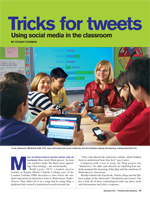A note from the Editorial Board
The Editorial Board takes responsibility for the Teacher Tip. We take our readers- concerns seriously, and we want to assure you that the Teacher tip — a new element introduced in the March issue — was not intended to diminish the value of any subject area being taught in Ontario schools. We will vet future tips more carefully.
While it's heartening to know that this new feature was so closely read, our aim was not to be controversial but to provide helpful advice that members can use in their daily practice.
We were also hoping that our first tip would help to generate the submission of even more tips from members. Any tips that you would like to submit yourself would be very welcome.
-The Editorial Board
Tipping point

It was with some concern that I read your Teacher tip in the March 2012 PS. Taking away time from subjects that students enjoy to improve classroom behaviour is not good pedagogy and is actually in opposition to best practice. While I recognize the importance of classroom management, the strategies used should be based on positive, not negative, behaviours. The tip mentioned that students “admonish each other to be quiet and pay attention,” which does not create an atmosphere for positive peer relations and a supportive classroom environment.
In addition, the curriculum expectations for health and physical education and the arts are important and mandatory, and there is great value in students having increased daily activity. Research has shown a connection between physical activity and better academic achievement, better classroom behaviour, better concentration and more focused learning. Daily physical activity is a mandatory component of daily instruction in Ontario. Students are required to actively engage in sustained moderate to vigorous physical activity for a minimum of 20 minutes every day. After physical activity, students are ready to engage in meaningful learning in the classroom.
Chris Markham is Executive Director and CEO of Ophea (provincial subject association for H&PE).All curriculum matters
The Teacher tip suggests that gym and art are not valued. Curriculum is important, whether it is the preferred subject of either students or teachers, and should be treated as such. Further, most research suggests that when students are unfocused, physical activities or creative outlets result in more effective learning.
Kristy Pulver, OCT, is Program Manager at an Ontario outdoor centre that provides outdoor, experiential and character education to students from Grade 1 through postsecondary.
Art and phys ed are important
I was disappointed to see that it is considered appropriate to manage student behaviour with the threat of the loss of arts education time. Art and gym might be popular, but they are also critically important. To reduce this time as part of a classroom-management strategy is not acceptable.
Carole Richardson, OCT, is Chair of Ontario Teacher Educators in the Arts and Dean of Education (acting) at the Schulich School of Education, Nipissing University.
Tip has “profound negative” impact
We were dismayed by and disappointed in the Teacher tip. This tip may have profound negative influence on teaching practice and the status of health and physical education.
We expect to see nothing less that quality and insightful strategies designed to support excellent classroom practice. We fail to see how this type of strategy, which punishes students and marginalizes mandatory curricular programming, can be deemed acceptable or even allowable. We wonder what was the standard and ethic of care in the decision-making process that allowed this tip to be published on behalf of and in support of Ontario teachers?
Joe Barrett, OCT, and Chunlei Lu are professors in the Department of Teacher Education, Brock University.
Give more time to phys ed
Physical education class is enjoyable and exciting for many students, but more importantly, it is a curriculum subject mandated by our province. Given the obesity epidemic in Canada today, students need more time on physical education than ever before. Suggesting that classroom teachers use this time as a prize to be granted or taken away devalues its importance in a child’s education. We need to value phys ed and give it the time it deserves.
Janie Kawamoto, OCT, and Kristin Kawamoto, OCT, both teach health an dphysical education in the Hamilton Wentworth DSB.The profession should do more to help new teachers

Having just read your article Now What? (PS, March 2012), it saddens me to know that our bright and enthusiastic new teachers are continually increasing their postgraduate unemployment and underemployment to over 30 per cent.
When I retired six years ago, I made it a personal and professional obligation to our new educators to step aside and do my small part to provide an opening for them.
I also made it quite clear to my colleagues that I was not enamoured with my retired peers who did double dip into the supply pool with a full pension. I was very happy when those available days were cut down so that at least some new teachers could get a small shot at actual classroom experience.
And now I also must strongly agree with Mr. Stoddart’s letter to the editor (March 2012), which suggests that postsecondary institutions should revise their entrance requirements and intake to stem the flow of poorly utilized teacher graduates.
I believe it is a more serious obligation on the part of the Ontario College of Teachers to immediately initiate a committee to work hand-in-hand with the teachers’ colleges to regulate this supply so we do not disillusion our new young professionals with future unreasonable prospects.
Doug Wighton, OCT, a former teacher and department head of ESL, is retired from Thistletown CI in the Toronto DSB.
Rookie teacher?
It is always with a sense of anticipaton that I greet each and every issue of PS. I am always able to mine many nuggets of wisdom. I will not, however, include the Teacher tip that appeared in the March issue as just such an example.
I wonder if Ms. Kovacs really thought through what her son’s Grade 6 teacher practices as a classroom-management strategy before choosing to include it. Picking physical education as a carrot (or is it a stick?) to change behaviour is like sending kids to bed without supper. These are important subject areas, and there will always be children who would be pleased to avoid either of those curriculum areas.
I would advise the teacher to find other ways to manage the class than timing “bad” behaviour. One could set aside periods for quiet time or schedule events where discussion is encouraged. Both of these alternatives focus on how to do things right. The opposite approach is a rookie mistake and perhaps it’s simply the case here.
Roger Curtis, OCT, teaches business at Sydenham HS in the Limestone DSB.Open letter to new teachers
Dear New Grads,
I graduated with a Master’s degree in Education in 1996 and was fortunate enough to get hired onto the supply list that September. It was tough to find full-time opportunities. Like many of my colleagues, I felt as though I was in the right place at the right time.
Seven years ago, I decided to resign my full-time teaching position to stay home with my four small children, all of them under the age of five. I walked away from that job thinking, arrogantly, that I would walk right back into the profession when my children were in school full-time. I was, after all, very experienced. But that, of course, was not to be the case.
But in my “time off,” I was an extremely involved parent volunteer in my children’s school. Still, I struggled to get re-hired into the profession. Once I did get hired, I rode the LTO train for three years. I knew I had to be much more than a good teacher in the classroom. I took many free seminars offered by my board and three AQ classes, but most importantly I took organizational roles in the school where I worked. At every opportunity I spoke publicly in front of students and parents.
Still, I rode the LTO train. It was discouraging, but thanks to supportive principals and administrative teams, I was never without a day’s work. When I finally gained my full teaching contract this year, it was because of dedication, creativity, consistent and hard work as well as being in the right place at the right time.
New graduates, you cannot expect that a teaching job will fall into your lap. Nor can you assume that being a great teacher in the class will be enough You must make very large promises to your students, your school and your parent community, and follow through. You must give of yourself to students, other teachers, your administrative team and parents.
Once you have shown commitment to all of this, then you must hope to be in the right place at the right time.
Jo-Anne Locke, OCT, teaches Grades K-8 music at Beryl Ford PS in the Peel DSB.Why “glorify” unacceptable classroom behaviour?

Although the character, Mr. Dee (Final Exam, March 2012), does not cross the line into sexual misconduct, he crosses pretty much every other line in his weekly shows. Any teacher thinking, wrongly, that this is acceptable behaviour need only read the Hearings pages just preceding your column. His shows are filled with many examples of inappropriate language, physical discipline and professional misconduct.
It might be cool to quote someone who “pokes fun at the profession,” but this is not why I pay my newly inflated fees to the OCT.
The College has done some good work educating its members on boundary and professional issues, but glorifying the behaviour of this TV character does no good at all and probable damage to young teachers looking for guidance.
Gerald M. Berish, OCT, taught Grades 9-12 history, geography, civics and economics before retiring from the York Region DSB in 2006.Technology is a learning tool — not the lesson focus

This email is in response to the letter to the editor in the March PS entitled Technology: Too Much Too Soon? As the teacher whose Grade 1 and 2 students were featured in the Tricks for Tweets article, I feel it’s important to respond to this post and address some of Skot’s concerns. Unfortunately, a still photograph does not capture the student interaction and collaboration that take place regularly and frequently in my classroom. If you check out my professional blog at adunsiger.com , my class blog at avivadunsiger.commons.hwdsb.on.ca or my student blog posts at missd.commons.hwdsb.on.ca, you will see for yourself many videos of students working and learning together. Often, students are even recording these videos on their own time and discussing what they’re learning and how they’re learning it.
Technology can be a great tool to use in the classroom, but I don’t think of the tool first and then plan my lessons and activities. The expectations drive all of what I do in the classroom.
The focus of this article was on using technology in the classroom, but this doesn’t mean that the children spend their entire day staring at a screen. I don’t have a 1:1 computer classroom, and while I do have access to a large number of different technology tools, students still regularly write in their journals, use math manipulatives, draw, cut, paint, use Plasticine, read books, explore the newspaper and read magazines.
My classroom is all about balance, and it’s about giving all of the students all of the tools that they need to be successful.
Aviva Dunsiger, OCT, is a Grade 1/2 teacher at Ancaster Meadow PS in the Hamilton-Wentworth DSB.Professionally Speaking welcomes letters and articles on topics of interest to teachers. We reserve the right to edit letters for length and to conform to our publication style. To be considered for publication, letters must provide the writer’s daytime phone number. Address letters to: The Editor, Professionally Speaking at ps@oct.ca or 101 Bloor Street West, Toronto, ON, M5S 0A1.